The name 'Angel Wing' Begonia can be VERY confusing. Luckily their care is much simpler than trying to work out which Angel Wing begonia you have. This guide will help with both. In fact this family of begonia are the hardiest, easiest-care of them all (and there are a LOT of different types of begonias). However, what you may have been told is an 'Angel Wing' (sometimes called a 'Dragon Wing'), is actually the common name used for the leaf shape rather than the exact variety, cultivar or hybrid you have.
This guide covers how to care for Angel Wing begonia, including light, watering, soil, temperature and more, plus problem-solving for common Angel Wing issues, as well as tips and photos to help you ID some of the more common varieties and cultivars...
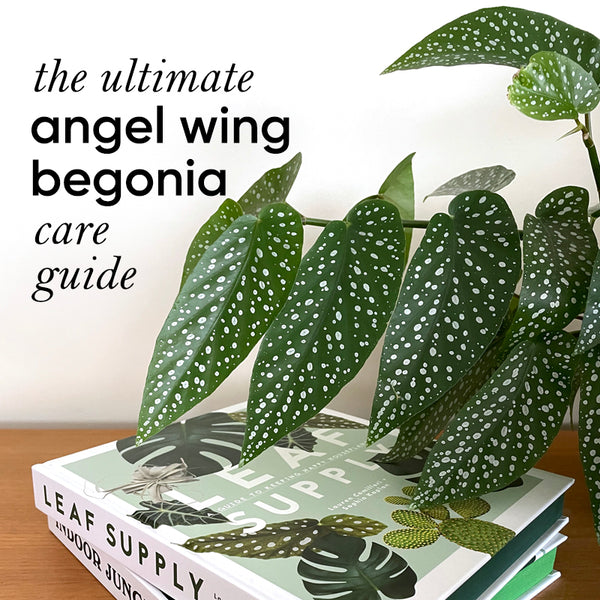
Which Angel Wing begonia do you have?
There are many gorgeous Angel Wing begonia that are hybrids without names and don't exactly match named varieties or cultivars you might find online. The reason Angel Wing are difficult to ID is largely because begonia varieties and cultivars are so easy to cross, but also because (until recently), begonia were restricted for what was able to be imported here, so hobbyists have got busy creating their own.
Now the rules have changed prepare to be wowed by all sorts of new begonias coming soon (my hand's up for Begonia 'White Ice' in particular, but there are so many with wow-worthy foliage), however, also keep in mind something a store sells as a named variety or cultivar might still be a hybrid.
Some you won't know for sure what you have until they flower, such as Begonia 'Orange Rubra' with it's scented, orange blooms, or the white flowers of Begonia maculata 'Wightii'. Some are easier to get an ID on from the leaves alone, like the very large leafed Corallina de Lucerna whose ruffled leaves can get larger than your head, or the Angelica which looks similar to Rosea Picta but with wider leaves with slightly frilled edges and the tips dipped in silvery white.
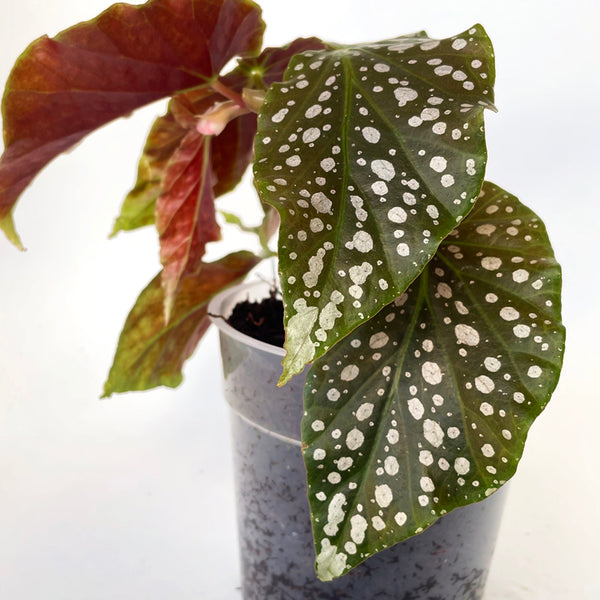
Above: Likely Begonia 'Angelica' or an Angelica hybrid. Note the wider leaf, slightly frilled edges and silvery white tips.
Another commonly confused pair are the narrower-leafed, more sparsely spotted Maculata compared to the wider-leafed, spottier Annan Grace, both which have distinct red backs to their leaves. To make it trickier, the conditions your Angel Wing is in can change the amount of spots, their size and colour, and the colour of the leaves.
That's why two Angel Wings can look very different, yet both be correctly called an Angel Wing begonia. Although your Angel Wing may not perfectly match a named variety or cultivar, and the chances it's a hybrid are high, one of the most common Angel Wing found here is what we call the Begonia Rosea Picta locally, also known as the Begonia albo-picta var. 'Rosea' overseas.
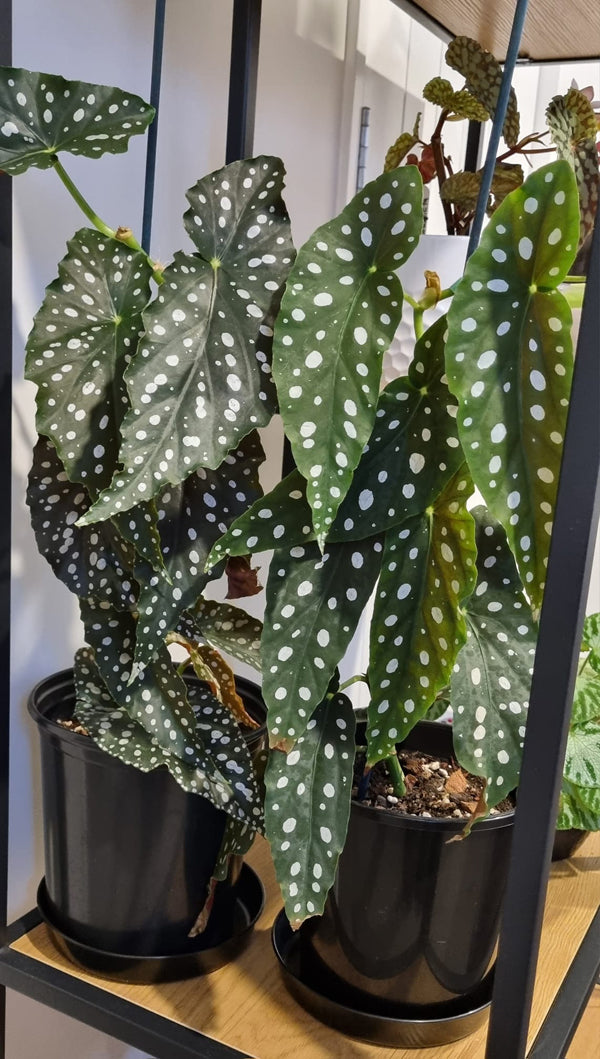
Above: Begonia Annan Grace LEFT and Begonia maculata 'Wightii' RIGHT. Credit Galina Shutkowski. Copyright image.

Above: Begonia Snow Capped TOP and Begonia White Ice BOTTOM.
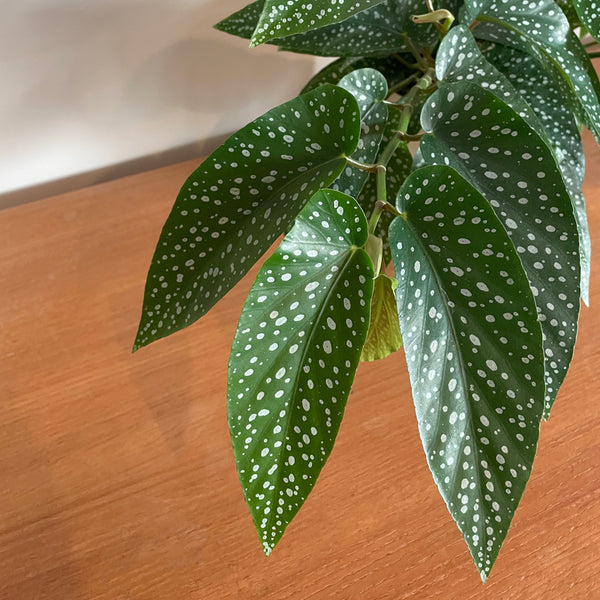
Above: The most common Angel Wing begonia available here is the Begonia albo-picta 'Rosea' (also known as 'Rosea Picta' or just Begonia albo-picta), which normally produces flowers in shades of pink.
What's the difference between a variety, cultivar and hybrid? (the short, simplified version)
Varieties are types of plants that have occurred naturally thanks to Mother Nature. Growing by seed will normally produce the same plant as the parent. Cultivar is actually short for 'cultivated variety' and knowing that alone makes it much easier to remember the difference.
In other words, a cultivar is a man-made variety we had a hand in creating. However, reproducing a cultivar can normally only be done by a leaf or stem cutting, not from seed. Hybrids however are crosses between different varieties or cultivars. They may take after one parent plant more than the other, or come out as a totally unique blend of the two.
Dogs make a great analogy to help understand the difference (simplified of course). A wolf would be the equivalent of a variety, a Labrador would be a cultivar, and a 'Labradoodle' (Labrador x Poodle) would be a hybrid.


Can you create seeds from a flowering Begonia?
Begonias are monoecious, meaning they produce separate male and female flowers on the same plant (compare them using the photos below), so yes, you can create seeds from a flowering begonia.
However, the male and female flowers do not normally bloom at the same time, so it can be a process over time, collecting the pollen from the male flowers (which normally bloom first) then pollenating the female flowers, and later harvesting and planting the seeds. If you're interested in creating and growing from seed, here's a good how to create begonia seeds from the American Begonia Society.
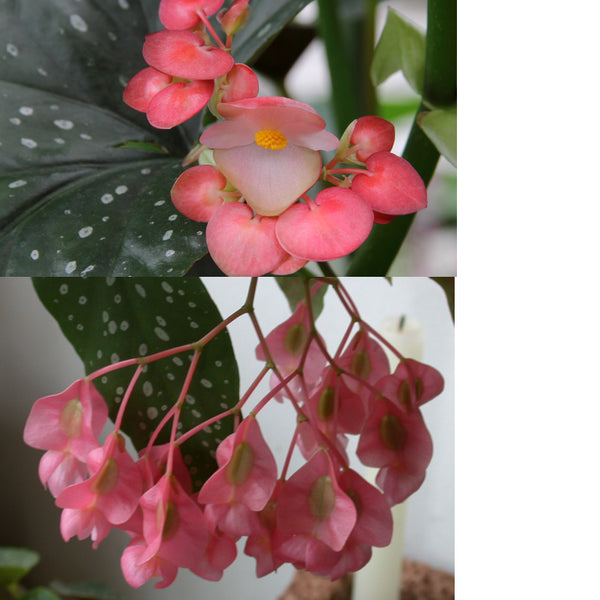
Above: TOP male flowers and BOTTOM female begonia flowers.
What type of begonia are Angel Wing?
Angel Wing Begonia are a type of Cane Begonia. Early green-leafed cane-like begonias were called Angel Wing begonias due to their wing-shaped leaves. However, the name is now used for most cane type begonias and has become so unhelpful when it comes to identifying which begonia you have, that begonia collectors have largely stopped using the name. Cane begonia are considered the easiest-care type of begonia.
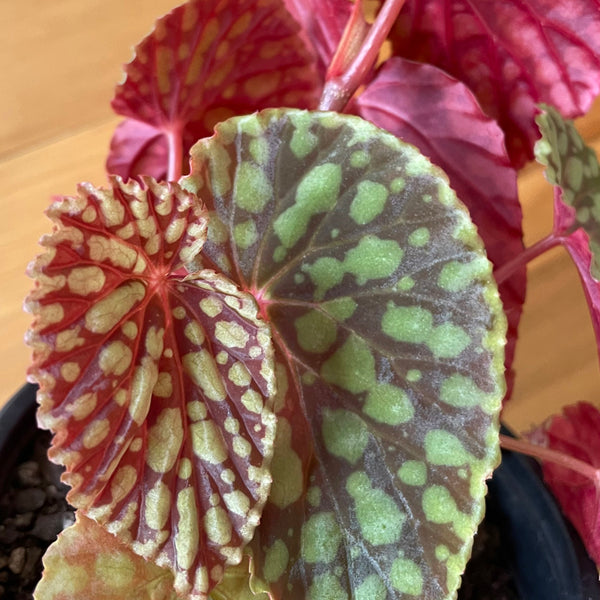
Above: Although spotted and with wing-shape leaves, the Begonia chlorosticta is a type of 'shruby' begonia, not a 'cane' begonia like Angel Wing are.
What are the 3 categories of Begonia?
Begonia hobbyist Colin Anderson helped answer this one: "Ornamental leaf Begonias can be classified under three sections, rhizomatous, which includes rex varieties, shrubby and 'cane' types. Many species and varieties are conveniently misidentified as 'rex' varieties, to which they often bear no connection, as with Begonia chlorosticta (above), which belongs to the section Petermannia & is more correctly described as 'shrubby'."
What light conditions do Angel Wing begonia prefer?
Bright, indirect light is ideal but they will tolerate lower light levels better than most. You'll get better variegation in the foliage when kept in medium light, but faster growth and flowers in brighter light. Once acclimatised, they also tolerate a little direct sun, but take it slowly getting them used to a little sunbathing indoors, and I find it best to stick to the weaker morning sun or winter sun.
What temperature range is best?
Warmth is appreciated by the Angel Wing begonia. Around 18 to 30 degrees (65-85 Fahrenheit), is a good temperature range, but they will handle lower temperatures indoors over winter provided the rest of the conditions are ideal. I aim to keep mine above 15 degrees.
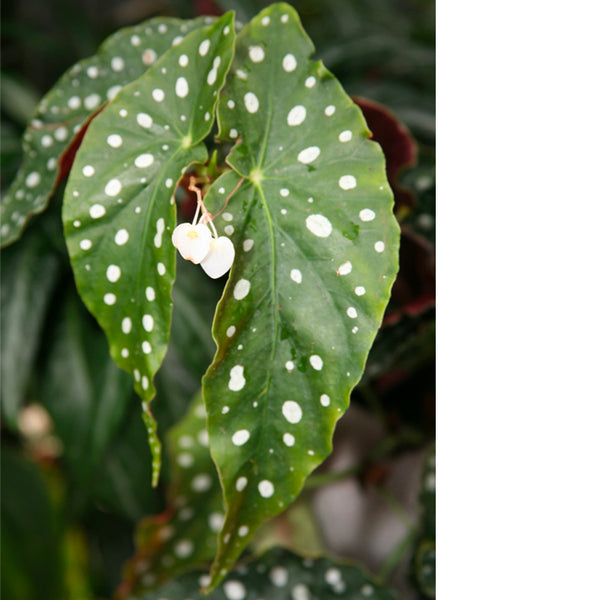
Above: Begonia Maculata.
What watering requirements do Angel Wing begonia have?
Angel Wing can be fast growers in the right conditions, and will happily drink everything you give them (within reason), so are more forgiving of over-watering than the average houseplant. If the other conditions are what they love (such as light and warmth), then aim to keep the soil lightly moist all the time.
Of course that's not always realistic to maintain, so a big help is picking the right soil to help you by retaining a decent amount of moisture. Don't go overboard of course and leave them sitting in water or keep the soil wet and waterlogged, but do avoid letting them fully dry out as they tend to go crispy very fast as the plant draws water out of the foliage to try and survive when the soil's too dry.
When watering, thoroughly saturate all the soil. Their roots are quite thin and fibrous, and you don't want to miss all the roots getting a good drink. Although they are somewhat tolerant of dry conditions, you won't get the leeway you would with a Pothos or Philodendron for example. Being left dry too long can stunt growth and lead to dry, brown tips and leaf margins. Leave it way too long and the whole plant can turn crispy and leaves start dropping.
In my plant parent journey I've changed from being an over-waterer to an under-waterer. Along the way I've found if you go too long between watering, Angel Wing can put themselves into a type of dormancy and just refuse to grow. If you've fixed all the usual things - water, light, fertiliser etc - and your Angel Wing is stubbornly refusing to grow, you may need to take a cutting and start again, but before you give up, you can also try a decent prune back to see if that kickstarts growth again.
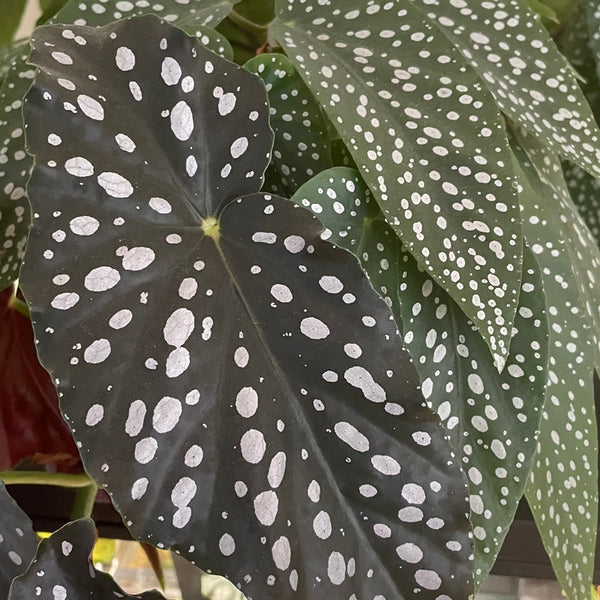
Above left: Sold here in stores as Begonia Maculata (although more correctly a Maculata hybrid), compared to the more common Begonia albo-picta var. 'Rosea' on the right.
What's the best potting mix for Angel Wing begonia?
Your choice in potting mix partly depends on your watering style. If you're prone to over-watering, go for a more free-draining mix but keep in mind you'll usually need to water your Angel Wing begonia more often than a typical houseplant in the same mix.
A fine-grade aroid mix is a good option if you don't mind the extra watering. I'd go about 80% fine aroid mix + 20% houseplant soil if you're happy to water more frequently. If you don't have a fine-grade aroid pre-mix available, succulent mix is a good back-up.
However, if you're more of an under-waterer, you'll want a mix that holds a bit more water. Increase the houseplant soil (or something else that holds more water but is still airy and free-draining). I'd mix around 50% houseplant soil or something similar like coco peat, with around 50% fine aroid mix or succulent mix to increase the drainage and air space. Another combo is houseplant soil and perlite, or cocopeat and perlite.
Overall, I find my various Angel Wings like a fine, rich, yet still airy and free-draining mix. Begonia often come from stores in a dense, rich, often peat-based, compact mix that holds a lot of water with little space left for air. Great for initial root development for growing baby Begonia at a nursery, but if your mix stays wet too long when you bring it home, I'd consider taking an insurance cutting, then repotting.
If you just can't nail the care of your begonia, my begonia hack is to take a cutting and start a new plant that's been grown in your environment from the start. Works every time for me, especially with my fussier Rex begonias. I find that less of an issue with Cane begonias like Angel Wing's however, so don't let that put you off!
Do Angel Wing begonia need fertiliser?
Absolutely yes. Like most moisture-loving, faster growers, Angel Wing begonia can be heavy feeders. That doesn't mean you need to add more fertiliser though, just fertilise more regularly to help avoid deficiencies. The weekly weakly method > is perfect for them (not literally weekly, just 'little and often' every time you water).
Without fertiliser, Angel Wing are more likely to 'steal' the nutrients they are missing in their soil, from their old leaves instead, 'sucking' them out of old growth to fuel their new growth to try and survive. One sign that's what's going on with yours, is when you see the older leaves nearer the base of the plant going dry or yellow and falling off, yet the new growth looks healthy and green. Start feeding!
Kept indoors, they don't die off or go dormant over winter, just grow more slowly. I feed mine all year round, and fertilise every time I water. Since I naturally water less in winter, they end up getting fertilised less often over the cooler, darker months without having to change their fertiliser routine.
How tall do Angel Wing begonia grow?
Angel Wing begonia are a type of Cane begonia, named after their segmented, bamboo-looking stems. Yes, your little spotted indoor plant buddy could end up VERY tall (1.5 metres+) depending on which one you have, but those heights are more typical when grown in ideal conditions outdoors.
Indoors, a good 30cms or so is more realistic but I've seen many a photo of them touching the ceiling growing indoors. I keep mine on the short side and regularly take cuttings, propagate them in water, and once rooted, re-plant them back in with the mother plant, creating much bushier plants. Left to their own devices the stems become surprisingly thick and boy can they shoot up! I also find mine stay bushier in general when kept shorter, but can get leggy if I let them get too tall.
Why are the spots on my Angel Wing begonia faded?
If you give your Angel Wing enough light to flower, that can come at the expense of the foliage. They tend to flower easily and almost constantly in the right conditions with plenty of bright light, however you may notice the leaves become a lighter green, are more likely to have brown leaf tips and edges, and the spots may become smaller, fewer or faded as well. Dial the light level back a little and you'll find the foliage will become darker green and you'll get the spots back again. Medium light levels bring out more contrast in variegation than brighter light.
Why does my Angel Wing begonia have dry, brown leaf tips?
This is most often either due to under-watering or too much light. Angel Wing don't like to fully dry out like many of our other indoor plants do. Existing brown tips are unlikely to recover but new growth should come through happy and healthy, and the existing tip damage shouldn't get worse once you fix the cause, but go ahead and trim the brown tips off if they bother you.
A possible but less likely cause in my experience is mineral burn, either from your tap water or fertiliser, although in my case I use low-salt, indoor fertilisers. If you're worried or just want to rule it out, rather than not feeding at all, shift to a low salt fertiliser. The usual high-salt ingredients to avoid are urea, sodium and chlorides. Not all fertilisers disclose a full ingredients list on the label, but often will on their websites, but you'll often find the better ones list everything and will tell you if they avoid those ingredients. One I use that has no urea, sodium or chlorides is GT (Growth Technology).
As far as your water source, mine are all on tap water with no signs of mineral burn, however not all tap water is the same of course. Rain water, distilled water or RO water are all options worth trying if you're worried. In my experience under-watering, inconsistent watering, or too much light are the more common reasons for brown tips.
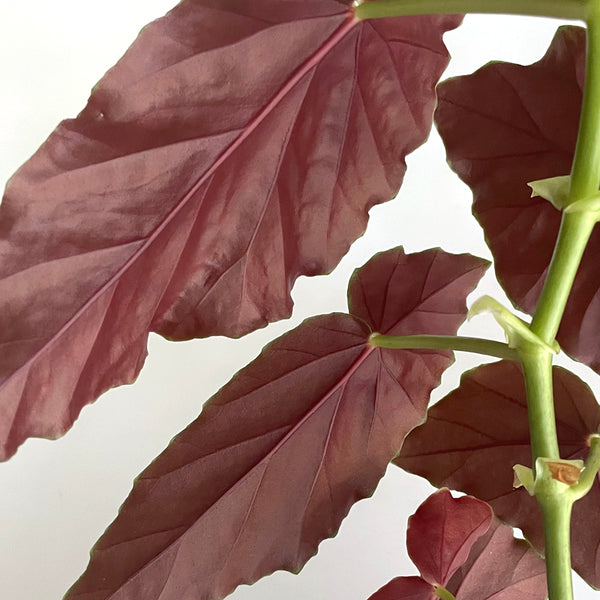
Above: Some Angel Wing begonia have dramatic burgundy-red undersides to their leaves, such as Maculata and Annan Grace.
Why won't my Angel Wing begonia flower?
You should get sweet little white, peach, pink or orange flowers regularly in the warmer months. My Begonia in my converted Ikea cabinet flower almost year-round. If yours hasn't flowered but is putting out new leaves, try shifting to a spot with more hours of light or brighter light. A fertiliser boost can also do the trick. A bloom fertiliser is worth looking for, as standard fertilisers for indoor plants are higher in nitrogen which keep the plant's efforts focused on growing foliage not flowers. One I recommend having used it with great results on my begonias is GT Flower Focus (their higher-nitrogen foliage formula - GT Foliage Focus - is superb also if you're not fussed about them flowering, and my begonias also love Plant Runner Indoor Plant Food which combines a higher-nitrogen fertiliser with seaweed, nature's super-food, in the same formula).
My Angel Wing is just not thriving even though I'm doing everything right
I find mine don't last forever. A good 2 or 3 years can be a good run for an Angel Wing. That's certainly not always the case, I know people have quite old Angel Wing's still going strong, but if yours isn't thriving despite getting the best care, consider taking a cutting and starting the plant again. A good prune back can also get things growing again.
Why are my Angel Wing begonia's leaves drooping?
The first thing to check is if you're meeting their watering needs. Drooping or wilting leaves is most often a sign of under-watering, but can also be related to over-watering. If you're confident it's not water related, a lack of calcium or silicon can also be to blame for weak stems and leaves. Check if your fertiliser is one that includes calcium. Also take a look at a silicon supplement like GT Silica.
Why are my Angel Wing begonia's leaves turning yellow?
There's only one reason for yellowing leaves. This is why >
Why is my Begonia growing leggy with long stems and not a lot of leaves?
Don't hide your Angel Wing in the dark or you'll let leggy growth, as this is most often a sign of reaching to find more light. If you regularly pinch back you'll get a fuller, bushier plant also. New stems will grow from where you prune. Plus they're easy to propagate too so don't throw out those pruned-off stems!
Another cause can be a simple nutrient deficiency. Make sure to feed your Angel Wing, ideally a higher-nitrogen fertiliser for foliage (Plant Runner and GT Foliage Focus are my top picks for leaf growth). Angel Wing begonia are typically fast growers so can be heavy feeders. See the section on fertiliser above first though, as it's not about giving them more fertiliser. There's a link in that section on the weekly weakly method, which is the method I use too.
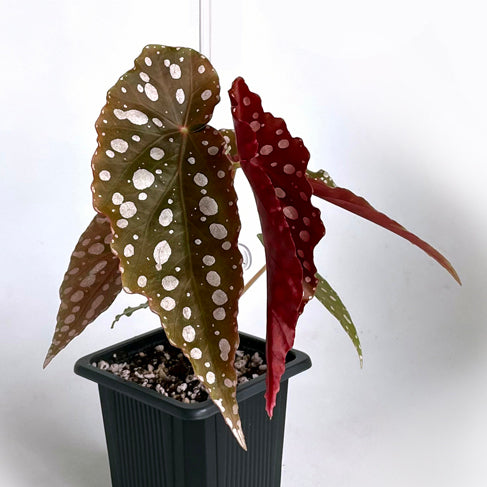
Above: A baby Begonia Maculata or maculata hybrid.
What is a Tamaya begonia?
Tamaya is normally used to describe the look of the plant based on how it's been trained to grow. If you see 'Tamaya' added to a variety or cultivar's name, it's not a different type of plant, it's just been trained to grow differently.
Tamaya are trained to be a standard with the foliage growth like an umbrella shape on top of a 'trunk'. Some begonia are easier to train than others. However, some people use tamaya to name their hybrids, but it’s not the official registered name.
Is the Angel Wing Begonia pet safe?
Unfortunately that's a no. Begonia are toxic to pets, and the Angel Wing is not an exception. It's rare for it to be serious, but pets could get sick from chomping on your Angel Wing, so best placed out of the reach of pets (and kids) just in case.
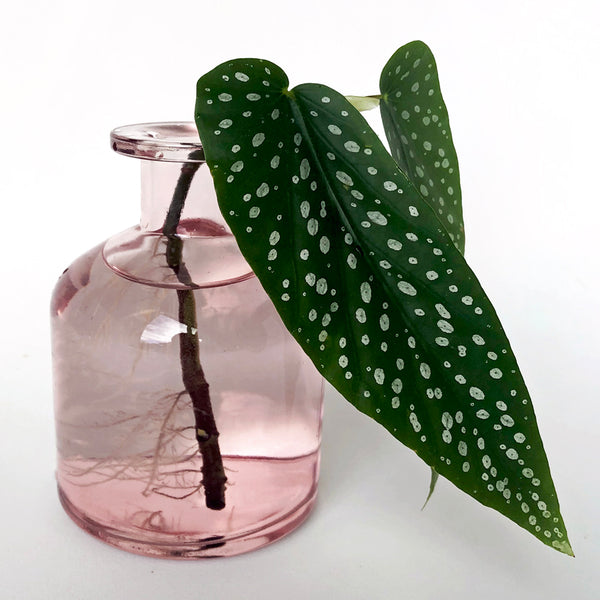
Above: Angel Wing begonia are generally fast and easy to propagate in water.
How to propagate the Angel Wing Begonia
Super easy to propagate but keep in mind, unlike other begonias, Cane begonias can only be propagated from stem cuttings, not individual leaves like other begonias can. I like to cut the stem roughly half way between two leaves, giving me a cutting with at least 4 leaves on it. Where each leaf grows from the stem is a node. That way your cutting will have multiple nodes on it. Fresh, growth tip cuttings root more successfully than older cuttings or cuttings from older stems.
I remove the bottom leaf or two, leaving 2 leaves on and some bare stem below. That way at least one bare node will be under water to start growing roots from. I usually propagate in water (you'll be amazed how fast roots start to grow on Angel Wings). You can put a stem cutting straight in to soil (with at least one node under-ground) if conditions are good, but it's not always as successful or fast to root as water propagation.
Pro tip: Once rooted, plant stem cuttings back in to the mother plant to create a much bushier effect.
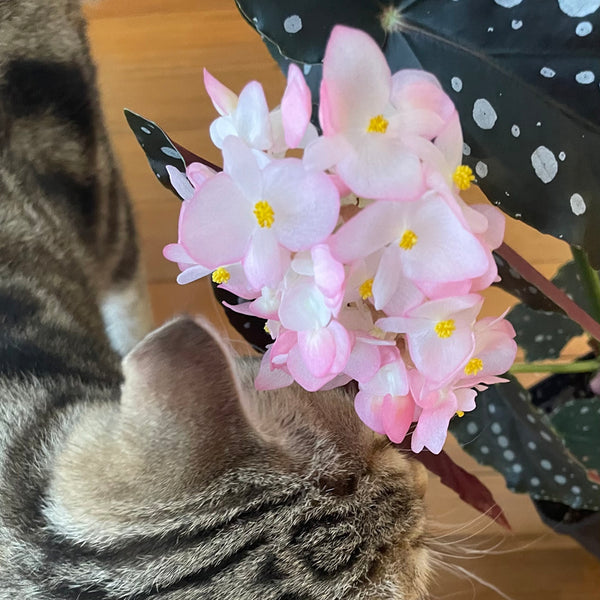
Above: One of my cats (Bumble) stopping to smell the pink-tinged white flowers on my Begonia 'Annan Grace'.
One huge caveat before you go. I consider myself a begonia enthusiast, but not an expert by any means! I may have a silly amount of begonia in my collection, mainly types of Cane and Rex begonias, but one of my favourite things about the houseplant hobby is we are always learning, especially when it comes to the tricky task of identifying begonia. If you have photos you'd like included to help others identify their begonia - which of course I will credit to you - please send them through >
Happy (spotted) growing,
Anna @lovethatleaf :)
